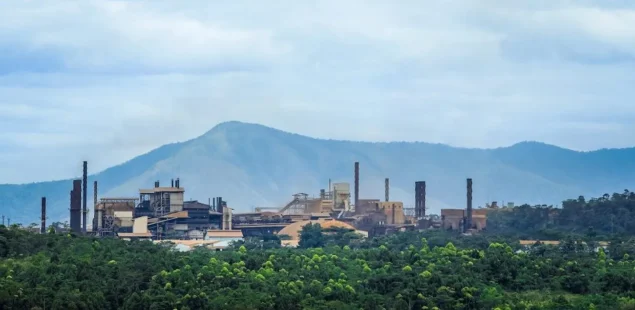
Global copper production overview
The global copper industry continues to expand, driven by accelerating demand from energy transition technologies, electric vehicles, and infrastructure projects. In 2024, global copper production reached approximately 22.8 million metric tons, with significant contributions from Chile, Peru, China, and the Democratic Republic of Congo. Chile remains the leading producer, accounting for approximately 25% of global output, followed by Peru and China.
However, supply-side challenges such as declining ore grades, geopolitical risks, and stricter environmental regulations are shaping the industry’s dynamics. These pressures are driving innovation, mergers, and increased exploration investments. The price of copper has remained relatively high due to these constraints, reinforcing the importance of established and emerging copper companies.
Leading copper mining companies are adapting through automation, ESG compliance, and strategic geographic diversification. Understanding the landscape of copper production and the key players is crucial for investors and industry analysts alike.
Top 10 copper mining companies
The top copper mining companies dominate global supply through large-scale operations and extensive asset portfolios. These firms combine technological sophistication with strategic geopolitical positioning:
- Codelco (Chile) – The world’s largest copper producer, fully state-owned, with annual production around 1.45 million metric tons. Major projects include Chuquicamata and El Teniente.
- Freeport-McMoRan (USA) – A key player with operations in the U.S. and Indonesia (notably Grasberg mine), producing around 1.4 million metric tons annually.
- BHP (Australia) – Through its Escondida mine in Chile, BHP contributes over 1 million metric tons of copper annually, making it one of the most efficient operators.
- Glencore (Switzerland) – Owns assets in Zambia, DRC, and South America, with annual production around 1 million metric tons. Known for trading and diversified mining operations.
- Southern Copper Corporation (Mexico/USA) – A subsidiary of Grupo México, operates in Mexico, Peru, and the United States, with consistent output above 900,000 metric tons.
- First Quantum Minerals (Canada) – Active in Zambia (Kansanshi, Sentinel) and Panama (Cobre Panamá), with growing output and expansion plans.
- Antofagasta (UK/Chile) – A pure-play copper company focused in Chile, with annual output exceeding 700,000 metric tons.
- Anglo American (UK) – Operator of the Quellaveco project in Peru, ramping up production with a long-term growth strategy.
- Teck Resources (Canada) – Known for its Highland Valley project in Canada and QB2 project in Chile, positioning itself as a sustainable copper supplier.
- MMG Limited (Australia/China) – Operates major assets in Peru (Las Bambas), with a strong presence in Asian markets.
These copper companies provide stable production, strong capital structures, and geographic diversity, making them central to the global supply chain.
Emerging copper producers to watch
While established players dominate in volume, several emerging copper producers are reshaping the competitive landscape:
- Ivanhoe Mines (Canada/DRC) – With its flagship Kamoa-Kakula project in the DRC, Ivanhoe aims to produce over 600,000 metric tons annually by 2026, making it a future heavyweight.
- Sandfire Resources (Australia) – Expanding globally with operations in Botswana (Motheo) and Spain, positioning itself as a mid-tier global copper firm.
- Hudbay Minerals (Canada) – Leveraging assets in Peru and the U.S., including the Copper World Complex, to increase production in the coming years.
- Ero Copper (Canada/Brazil) – Focused on high-grade underground mining in Brazil with scalable operations and low-cost structures.
- Arizona Sonoran Copper (USA) – A U.S.-based development-stage firm with promising assets aligned with domestic supply chain needs.
These copper companies are attracting investor attention due to scalable resources, lower-cost operations, and strategic positioning in emerging markets.
Investment opportunities in copper mining
Copper companies present diverse investment profiles. Established players like Freeport-McMoRan and BHP offer stable dividends and scale, while firms like Ivanhoe Mines or Hudbay provide high-growth potential with greater risk exposure.
Key investment criteria include:
- Reserves and production growth: Projects with long mine life and scalable reserves are valued higher.
- Cost structure: Low all-in sustaining costs (AISC) enhance margins during price volatility.
- ESG practices: Investors increasingly favor companies with robust environmental and governance frameworks.
- Geopolitical exposure: Operations in low-risk jurisdictions are often priced at a premium.
Copper demand is projected to increase by 50–70% by 2035, fueled by electrification and decarbonization. This makes copper shares a compelling long-term investment, though subject to cyclical commodity risk. Analysts expect a structural supply deficit post-2026, reinforcing bullish sentiment.
Environmental and sustainability initiatives
Sustainability is no longer optional for copper mining companies. Top firms integrate ESG at the core of their strategy:
- Codelco aims to reduce its carbon emissions by 70% and water use by 60% by 2030, shifting to desalinated water and renewable energy.
- BHP has committed to net-zero operational emissions by 2050, with interim targets including reducing Scope 1 and 2 emissions by 30% by 2030.
- Freeport-McMoRan implements innovative tailings management, biodiversity offsets, and extensive community engagement programs in Indonesia and Arizona.
- Teck Resources adopted the “Copper Mark” certification across its projects, enhancing traceability and environmental compliance.
- Antofagasta uses 100% renewable energy across its operations, and is investing in dry tailings and water recycling.
Such initiatives not only reduce regulatory risk but also attract ESG-focused capital and long-term investors.
Future outlook for the copper industry
The copper industry faces a paradox: surging long-term demand against constrained supply. With global net-zero goals and electrification, annual copper demand could reach 35 million metric tons by 2035, creating a significant supply gap.
Challenges ahead include:
- Resource depletion: Ore grades are declining globally, requiring more capital to maintain output.
- Permitting delays: Regulatory and social license issues delay new projects, as seen in Peru and the U.S.
- Capital discipline: Companies are cautious post-commodity boom, slowing supply growth.
However, innovation in extraction methods, automation, and recycling will play a critical role. Companies investing in technology and sustainability will likely lead the next growth cycle.
FAQ
What is the best copper mining company to invest in?
The “best” copper company depends on your investment strategy. For stability and dividends, Freeport-McMoRan and BHP are industry leaders. For high-growth potential, Ivanhoe Mines offers significant upside with its low-cost Kamoa-Kakula project. Southern Copper and Teck Resources provide a balanced mix of growth and dividends, making them strong mid-tier options.
What is the largest copper mining company?
Codelco, Chile’s state-owned mining giant, is the largest copper mining company globally by production. It consistently produces around 1.45 million metric tons annually, and operates the world’s largest copper reserves. It leads in scale, efficiency, and national strategic importance.
Who is the top 10 largest producer of copper?
The top 10 copper mining companies by production are:
- Codelco
- Freeport-McMoRan
- BHP
- Glencore
- Southern Copper
- First Quantum Minerals
- Antofagasta
- Anglo American
- Teck Resources
- MMG Limited
These copper companies dominate global output and are strategically positioned across resource-rich regions.
Are copper shares a good buy?
Yes, copper shares can be a strong long-term investment, especially given the metal’s crucial role in clean energy, EVs, and infrastructure. However, copper prices are cyclical, so timing and diversification are key. Top copper mining companies offer a blend of dividend income and capital appreciation potential, with some exposure to geopolitical and operational risks.



